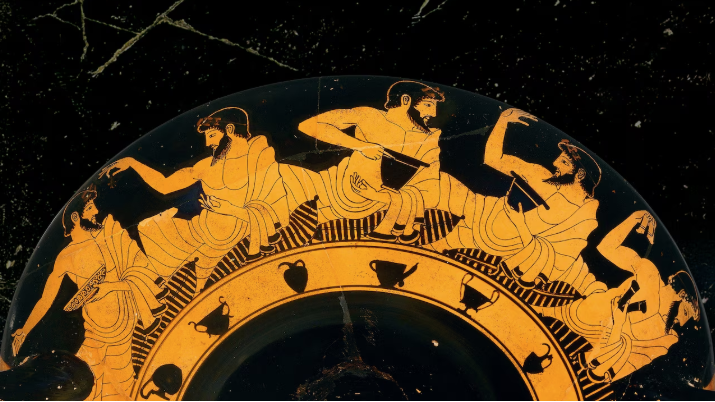What exactly was an ancient Greek symposium - More complicated than you think
- Written by E.Tsiliopoulos
The symposium in classical Athens was a social event, attended only by men, and had a private or public character. Symposiums were held on the occasion of family celebrations, city festivities, athletic victories, poetic competitions, due to the arrival or departure of a friend, while very often men of the mainly aristocratic class gathered to dine together. The symposium had two phases: the meal and the symposium itself. In the first phase, wine was consumed in limited quantities, while in the second, which lasted longer, the banqueters drank wine, which they accompanied with tragedies.
The wine was usually mixed with water in a ratio of 1 to 2, or 3, while the vessel in which the mixing took place was called a krater. Undiluted wine (akratos oinos) was drunk only when a toast was made or in other exceptional cases. The slaves -young men or women- served the drink in metal or, more commonly, clay vessels, and the banqueters entertained themselves with discussions, poetry recitation, riddles, puzzles, music, dances, spectacles and games, such as the kottavos.
Athenian women did not normally take part in the banquet, except to accompany and entertain the men, mainly in the second part of the banquet, as musicians (aulitrides), dancers and hetaerae. The symposium was an educational space for the adolescents of the aristocratic class, who had the opportunity to be present, to follow the discussions of the symposium participants and to be initiated into the values of their class.
The symposiums took place in the courtyard of the houses or in public buildings, in the case of being organized by the city. The symposium participants usually ate and drank lying on couches in groups of two and rarely in groups of three, leaning on their elbows and with their torsos upright or slightly inclined, often supported by pillows or large headrests. The places of honor were next to the host, who could designate the position of each banqueter. The tables were small and portable, one for each banqueter or one in front of each couch. The banquet room was small. Seven to twelve couches were usually placed along the walls or in such a way that everyone was on the same level and each banqueter could see the others. This facilitated the immediacy of communication and conversation, which were essential features of the banquet. Finally, even the public banquet rooms were not large.
The guests, upon arriving at the house where the banquet was to be held, took off their shoes. The servants washed their feet and led them to the banquet hall. The guests often wore wreaths of leaves or flowers and carried ornaments, the hypothymides, on their chests. As soon as they took their places, the servants offered them a wine-bowl and a basin (chernips) to wash their hands. The dinner began with the propoma, a glass of perfumed wine, from which all the guests drank before eating.

Some of the guests arrived after dinner, to participate only in the banquet itself, which began with libations to the gods and mainly to Dionysus, the god of wine. The libation consisted of drinking a little unfermented wine and pouring a few drops while pronouncing the name of the god, to whom they then sang a hymn. A draw followed to determine the leader of the banquet (symposiarchos), who determined the proportion of wine and water to be poured into the vat and the number of glasses that each guest had to empty. If someone did not obey the symposiar, he was obliged to carry out a sentence.
The participation of the symposiars in the song was also a characteristic element of the symposium. Based on the testimonies of Aristophanes and Athenian, a branch was passed from hand to hand by each symposiar, marking the turn of each in the song, which often had a predetermined theme. In other cases, the symposiar continued the song that his neighbor had begun (skolion). In the vase painting, symposiars are depicted singing with the accompaniment of aulos. Often, when the symposium ended, everyone was drunk. Depictions of symposia are a very popular theme in classical Attic vase painting.
Related items
-
 Peter Georgiopoulos: Return to Wall Street with new SPAC – Raised $230 million.
Peter Georgiopoulos: Return to Wall Street with new SPAC – Raised $230 million.
-
 Thessaloniki: Young men who beat and stripped men who made appointments with minors are accused of forming a criminal organization
Thessaloniki: Young men who beat and stripped men who made appointments with minors are accused of forming a criminal organization
-
 Today is the last cabinet meeting of 2025 with the agenda of 2026 reforms and a new message from Mitsotakis to the blockades
Today is the last cabinet meeting of 2025 with the agenda of 2026 reforms and a new message from Mitsotakis to the blockades
-
 Greece-Israel-Cyprus build defense axis: Message of deterrence to Ankara and Tehran
Greece-Israel-Cyprus build defense axis: Message of deterrence to Ankara and Tehran
-
 The Greek Christmas dessert that was named the best in the world
The Greek Christmas dessert that was named the best in the world
Latest from E.Tsiliopoulos
- Peter Georgiopoulos: Return to Wall Street with new SPAC – Raised $230 million.
- Aikaterini Laskaridis Foundation: Awarded by the Academy of Athens for its contribution to culture and education
- Thessaloniki: Young men who beat and stripped men who made appointments with minors are accused of forming a criminal organization
- Today is the last cabinet meeting of 2025 with the agenda of 2026 reforms and a new message from Mitsotakis to the blockades
- Greece-Israel-Cyprus build defense axis: Message of deterrence to Ankara and Tehran



